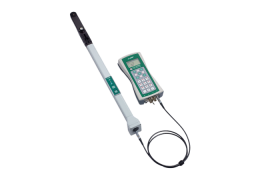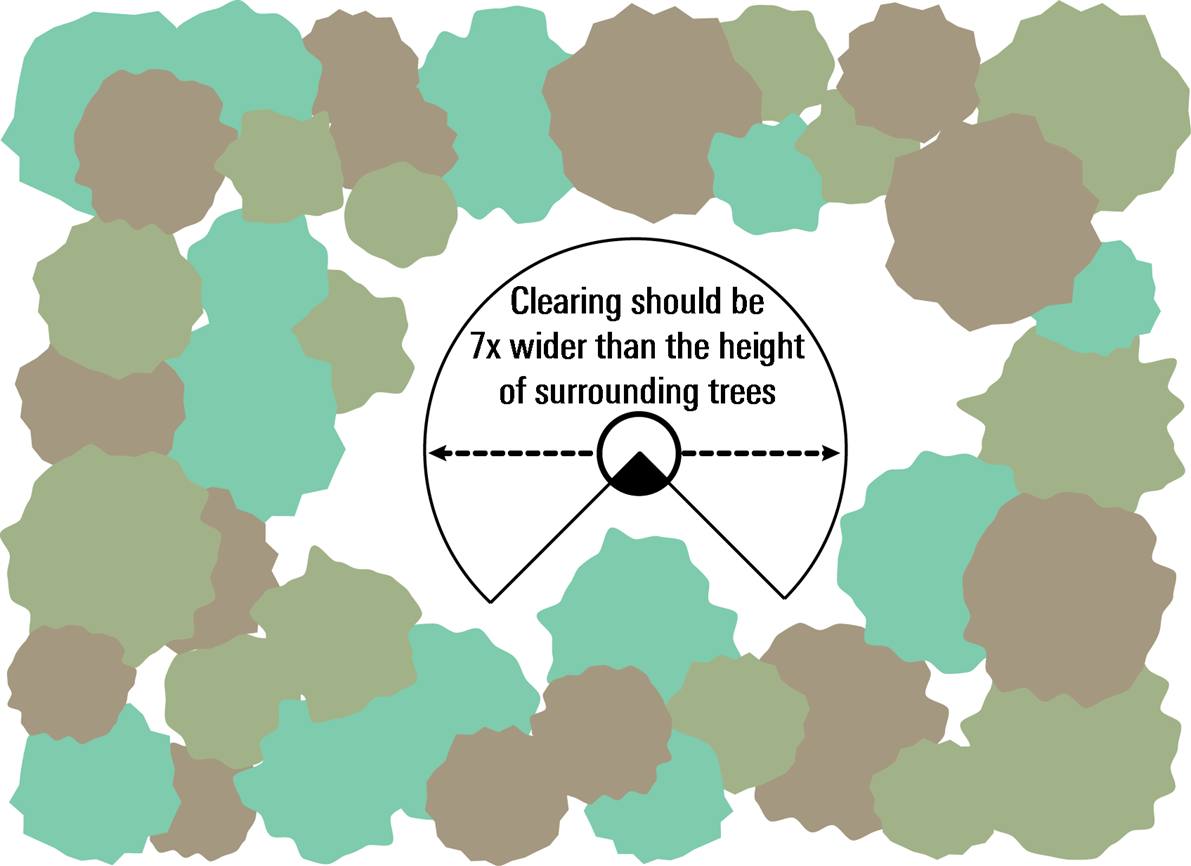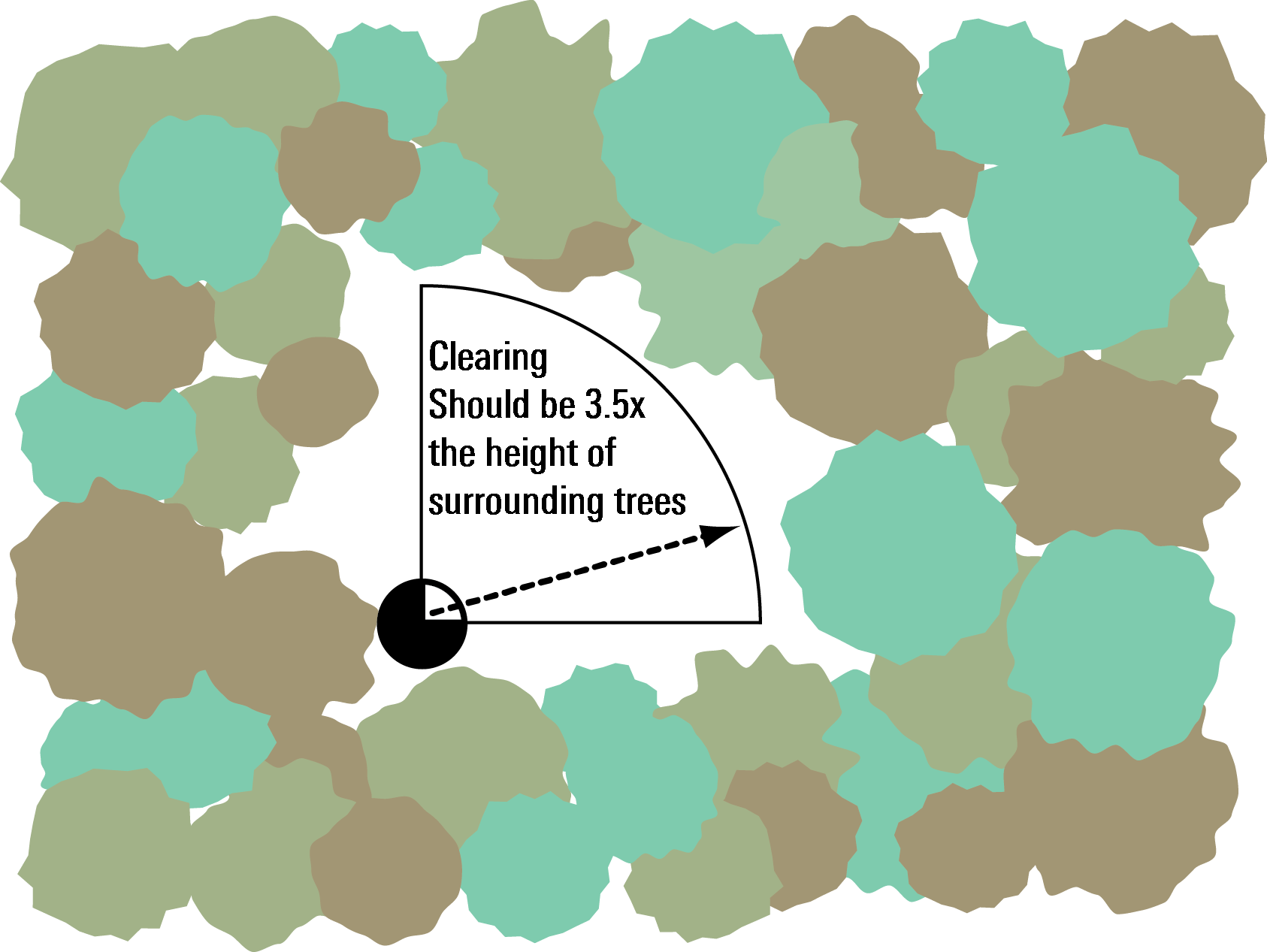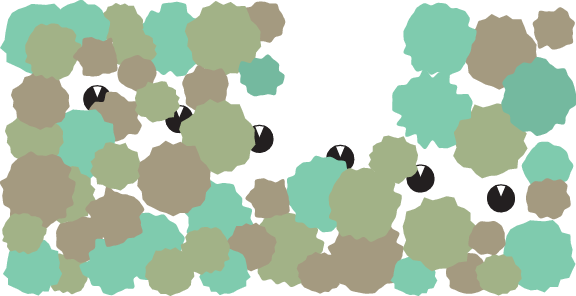Short Homogeneous Canopies
Short homogeneous canopies are the simplest to measure. Under stable sky conditions with a 270° view cap, one A reading for four or more B readings should be sufficient. To reduce uncertainty of measurements, you can take more B readings.
Small Plots
When measuring small plots, it is important to be sure that objects outside the plot do not influence measurements. From beneath a canopy, the optical sensor’s potential view is conical, with a radius that is about 3 times the canopy height. The optical sensor (wand) has a view of 74° (tan (74)=3.48). However, 3 serves as a working number because of the reduced probability that foliage will be significant at the edge of the sensor’s field of view.
In a canopy that is 1 m high, the optical sensor should be at least 3 m from the edge in any direction that it can “see”. In a plot so small that the sensor will “see” outside the plot area if measured from the middle, one could use a 90° view cap and make readings from the corners looking into the plot. Alternatively, a 180° view cap could be used if the measurements were taken near the center of the plot.
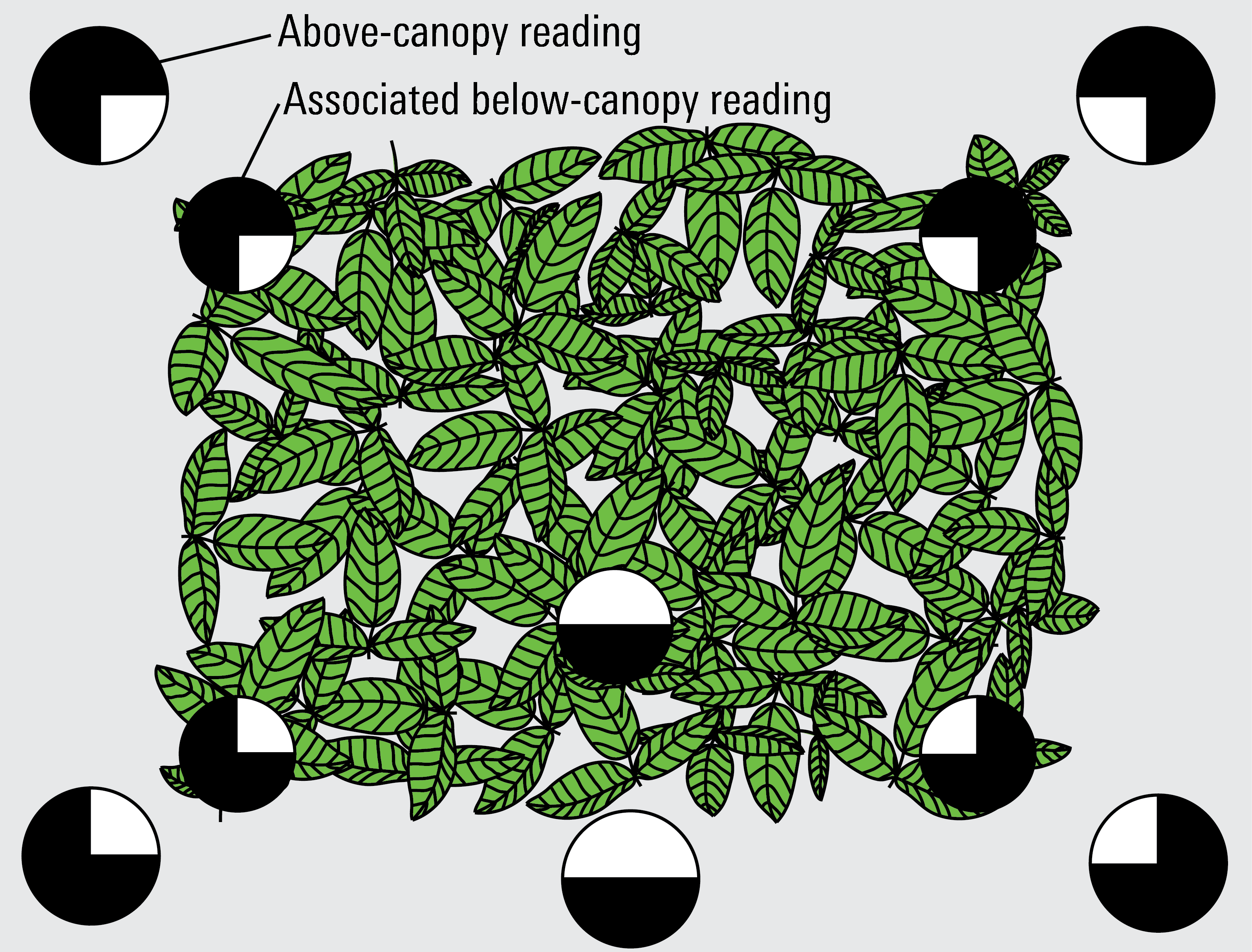
Note: If the sun is out, you may need a K record (e.g. a 4A sequence) for each view cap and direction you use. See Dealing with Scattering.
In dense canopies, the minimum plot size may be reduced if foliage blocks enough of the optical sensor’s view. This is easily tested by getting down on the ground and looking up at about a 30° elevation angle. If you are unable to see the edge of the plot from this vantage point, then the plot is large enough regardless of its actual dimensions.
An additional method for measuring small plots is to do the LAI computations without the outer ring. Without the outer ring, the minimum plot size decreases to 1.6 times the canopy height. The outer ring can be omitted with the Mask function prior to data collection (Procedure 2.10 - Excluding Rings from Analysis - Console), after data collection but while the file is still on the control unit (Procedure 3.7 - Recomputing a Data File - Console), or after the file has been moved to a computer (Procedure 3.5 - Excluding Rings from Analysis - FV2200).
Row Crops
Row crops, with architecture ranging from very wide row spacing to closed canopy, can be measured accurately using the technique described here. In general, readings should be made along diagonal transects between the rows, as shown in Figure F‑1. Choose locations along transects so that readings are made at even intervals across the row. For example, if making 4 B readings per transect, make the first in the row, the second ¼ of the way between the rows, the third at mid-row, and the fourth ¾ of the way across. Measuring with a diagonal transect, rather than a perpendicular transect, improves spatial averaging.
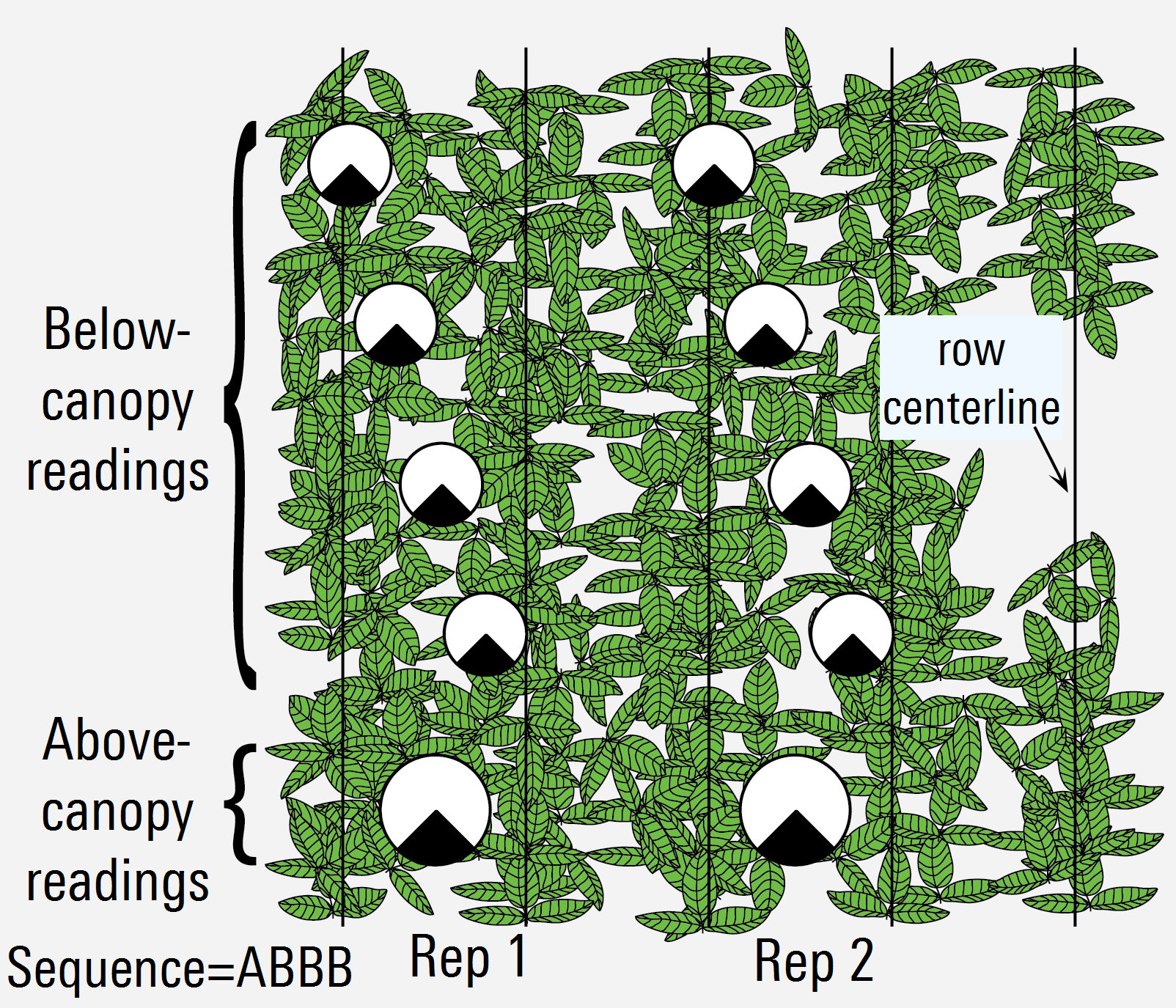
Be sure to make all B readings at the same height; if furrows and mounds cannot be smoothed, position a board along the transect and rest the sensor on it when taking readings.
If the rows have significant gaps where vegetation is lacking, perform the Canopy Gap Test (see The Gap Test) to see if these gaps merit special attention. If the Gap Test error is less than 10% (homogeneous canopy), then use as wide a field of view as possible, depending on sky conditions. If the Gap Test error is greater than 10% (heterogeneous canopy), then use the 45° view cap and double (at least) the number of diagonal transects. Measure the transects in pairs: one transect with the sensor looking along the row, and the other with the sensor looking across the row, as shown in Figure F‑1.
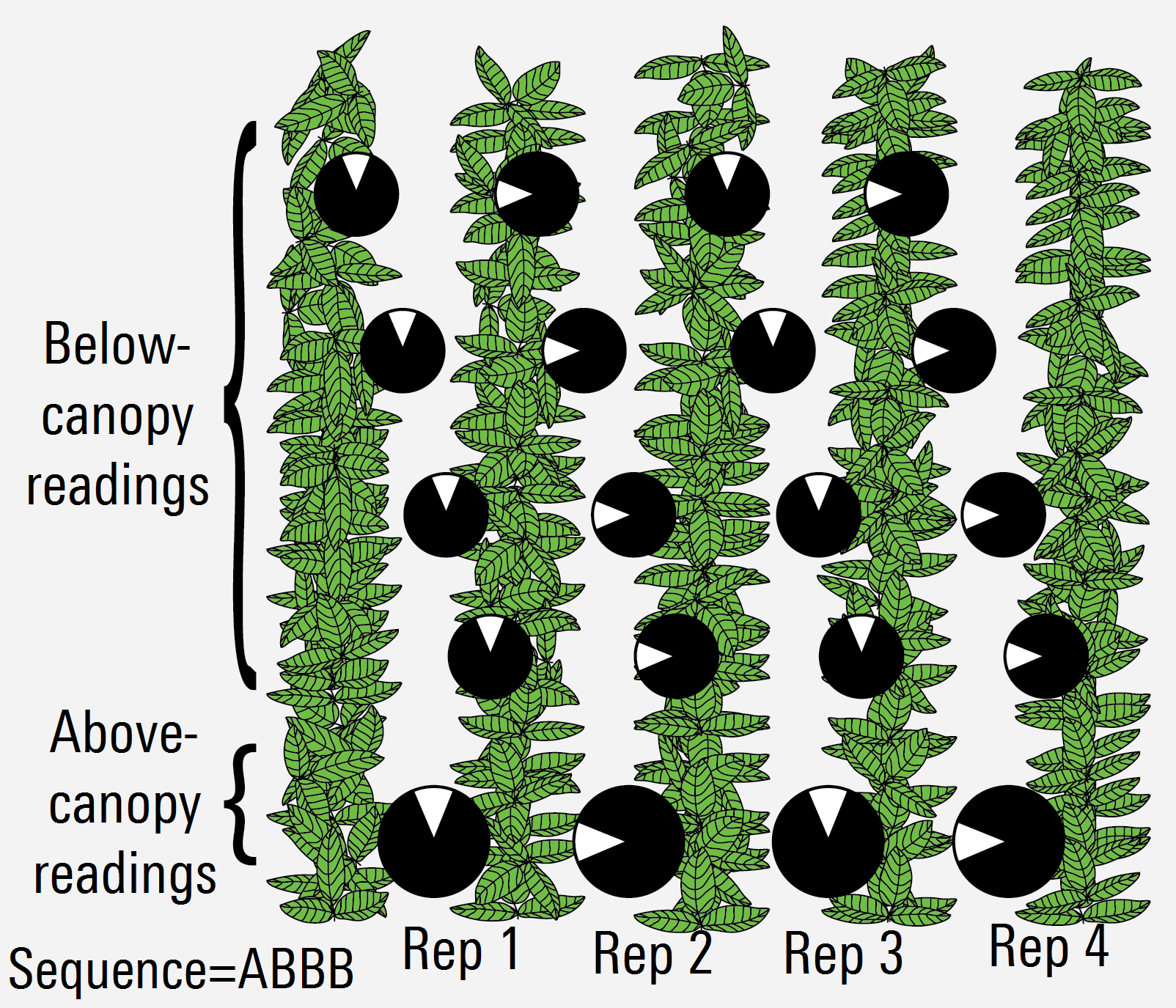
Note: if the sun is out, you may need a K record (e.g. a 4A sequence) for each view cap and direction you use. See Dealing with Scattering and Measuring Non-Uniform Canopies with Direct Sun for details.
Tall Canopies and Forests
The primary challenge to measuring very tall canopies is getting the A readings.
Single Sensor: A single sensor can be used effectively in forests when there is clear blue sky. In such conditions, you will want to do a 3A or 4A sequence in a suitable clearing or on a tower, then make the B readings under the forest canopy at your plots or along your transects. You can then return to the clearing and do final 4A sequence. Example 4 - Forest Sites with One Sensor (and Control Unit) illustrates how to do this. And in fact, you can also do the same with simply a sensor by itself, following Example 5 - Forest Sites with One Sensor (without Control Unit). This means if you happen to have a control unit and two sensors (and two people), you can use both and get your measurements done twice as fast, since you can split up the below canopy work. The above canopy data can come from just one unit, or each can get its own, letting you bypass any sensor matching.
Two Sensors: Refer to the discussion in Multiple Sensors With Scattering Correction.
Note: If the sun is out and you are measuring a forest canopy with large gaps, choose a view direction to the side or slightly in front of the sensor’s view (taking care of course to not take a reading with the sun actually in the field of view). see Measuring Non-Uniform Canopies with Direct Sun for an illustration and discussion.
Making A Readings in Forest Canopy
There are several considerations for getting A readings in a forest canopy.
A readings should be made as close as possible to the site to be measured. The maximum acceptable distance depends entirely on sky conditions. With blue sky (ignoring the sun for a moment), the two sensors could be kilometers apart and still see the same sky brightness distribution. With an overcast sky, however, the lower the clouds, the greater the probability that two sensors some distance apart will see different skies, especially with the central rings (near the zenith). A low, heterogeneous overcast sky with quickly moving clouds is the worst case, when even 100 meters could be too great a distance between the sensors.
If making A readings in a clearing, be sure that the clearing is big enough. With a 180° or larger view cap, the sensor should be in the middle of a clearing with a diameter at least 7 times the height of the trees above the sensor (2×tan74°≈7).
With the 90° or 45° view cap, however, a clearing half that size (diameter only 3.5 times the tree height) can be used, since the sensor can now be positioned on the edge of the clearing (looking in).
This is a common reason for using a narrow view cap in a forest. Neglecting the outer ring may be necessary if an adequately large clearing is not available. In that case, the clearing should be 1.5 times the canopy height if the 45° or 90° view cap is used. Refer to the Small Plots.
When making A readings for forest canopies, clearings can be made “bigger” by raising the sensor. Use the bottom level and hold the sensor over your head. The sensor can be elevated by standing on a stump, the cab of a vehicle, or by raising the sensor with a long pole, etc.
Don’t forget: The A readings should be made with the same view cap (covering the same part of the optical sensor), sensor inclination (if the ground slopes), and direction of view that the B readings will have.
Making K Records in a Forest Canopy
K records (or more precisely the precursors to them) have similar considerations as A records, plus a few. (If you aren’t sure what K records are, see K Records). If the A unit is going to do double duty as the K unit, as described in Procedure 2.12 - Getting K Records on an Above Sensor, then the first and third readings of a 4A sequence need some consideration:
The first A reading (sunlit diffuser) needs to be in the sun. If the site in the reference clearing where the A unit is located happens to be shaded, then that is a problem.
The third A reading is the wide sky reading. Unless your A site happens to be on top of a tower above the canopy, it is not likely to have an unobstructed view of the sky in all directions. You will have to choose a view cap for the third reading that is as large as will work. The worst case would be if that view is no larger than the normal A view, in which case you can just skip that reading, as described in Embedded Bs.
Canopies with Large Gaps
LAI is proportional to the logarithm of the gap fraction, so the proper way to average gap fractions is to average their logarithms (Lang and Xiang, 1986). This in fact is how the LAI-2200C averages multiple B readings in a file. However, each B reading is a linear average of the light from whatever azimuthal view is visible to the sensor, as determined by the view cap. Problems can arise if the sensor sees dense foliage in one direction and little or no foliage in another direction at the time a B reading is recorded, because the gap in the canopy will be “over weighted”, and LAI will be underestimated. A way to avoid this problem is to use a view cap to restrict the sensor’s field of view, so that dense and sparse regions of the canopy are included in separate B readings. The figure below illustrates how a 45° view cap helps isolate a gap near a transect.
If on the other hand, you wish to measure Le (effective LAI), then you do not want the instrument to log average. In this case, use a wide field of view (270°), and multiply your resulting LAI by ACF, the apparent clumping factor.
The Canopy Gap Test (see The Gap Test) can be used to estimate the error of using a wide field of view in a heterogeneous canopy, when large gaps and foliage are included in the same B reading.
Note: When the sun is out and you are measuring canopies with large gaps, choose a view direction to the side of or slightly in front of the sensor's view (taking care of course to not take a reading with the sun actually in the field of view). See Protocol Suggestions for Direct Sun for an illustration and discussion.
Conifers
It is well known that conifer needles are not arranged in space randomly, and radiation penetration models that make that assumption will underestimate the transmittance of a conifer canopy (for example, Norman and Jarvis, 1975; Oker-Blum and Kellomaki, 1983). Since the LAI-2200C assumes random foliage positioning, it will underestimate LAI in conifer canopies.
Numerous researchers have developed sampling techniques for acquiring accurate LAI measurements in evergreen forests, including Chen (1996), Stenberg (1996), Chen et al. (1997), and Kucharik et al. (1998). A detailed sampling protocol for conifer stands is described in Law et al. (2008).
The Gap Test
The canopy gap test is a quantitative way to estimate the error of using a wide field of view in a heterogeneous canopy. That is, a canopy with dense foliage in some areas and sparse (or no) foliage in others. The problem is that LAI is proportional to the logarithm of the gap fraction, but for any one reading, the sensor will linearly average gap fraction over its view. If the sensor’s view includes both dense and sparse foliage areas, the gap fraction for that B record will thus be incorrectly averaged. If the dense and sparse regions are measured in separate B records, they will be correctly averaged.
Follow Procedure 1.11 - The Canopy Gap Test to estimate the error from using a view cap that is too large.
